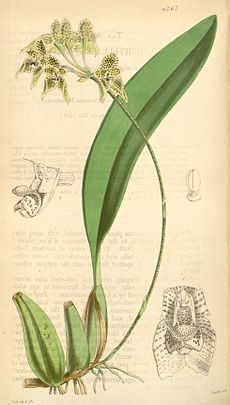| Bulbophyllum umbellatum | |
|---|---|
 Bulbophyllum umbellatum | |
| Cronquist classification | |
| Domain | Eukaryota |
| Reign | Plantae |
| Division | Flowering Plant |
| Class | Liliopsida |
| Order | Orchidales |
| Family | Orchidaceae |
| Subfamily | Epidendroideae |
| Tribe | Dendrobieae |
| Subtribe | Dendrobiinae |
| Gender | Bulbophyllum |
| Species | B. umbellatum |
| Classification APG | |
| Order | Asparagales |
| Family | Orchidaceae |
| Binomial | |
| Bulbophyllum umbellatum Lindl. , 1830 | |
| Synonyms | |
Cirrhopetalum umbellatum
(Lindl.) Linden, 1881 nom. illeg. Phyllorkis umbellata (Lindl.) Kuntze, 1891 | |
Bulbophyllum umbellatum Lindl. , 1830 is a plant of the family of the Orchids , native to Southeast Asia . [1]
Description [ change | edit wikitext ]
It is an orchid small, often minimal, with behavior epiphyte . B. umbellatum presents pseudobulbs spaced 1 or 2 centimeters, in shape from ovoid to broadly conical, wrinkled, wrapped at the base by a fibrous sheath, bearing at their peak single leaf petiolate, leathery, elliptical shape closely to acute apex. Flowering occurs in spring , with an inflorescence baseline, thin, average 20 cm long, carrying 5 to 8flowers gathered in umbel. The flowers are large 2 to 4 cm, fragrant, white spotted with red, and have sepals characteristic: the median is oval in shape with acute apex, while the two sides are more elongated and facing down. The petals are smaller than the sepals and the lipis sac-like. [2]
Distribution and habitat [ change | edit wikitext ]
The species is native to Southeast Asia , in particular the chain of ' Himalaya , the state of India 's Assam and Nepal , Bhutan , Myanmar ,Thailand , China Southern and Vietnam .
Epiphyte grows on trees in forests of mixed conifers , often dwarf trees, gnarled and covered with moss, at altitudes between 1,000 and 2,200 meters above sea level. [2]
Taxonomy [ change | edit wikitext ]
- Bulbophyllum umbellatum 'var. Fuscescens (Hook.f.) PKSarkar, 1984
- Bulbophyllum umbellatum var. Umbellatum
Cultivation [ change | edit wikitext ]
This plant requires exposure to partial shade in cultivation, warm temperatures all year round, at the time of flowering is necessary to increase the temperature and administer water. [2]
CITIES category : Appendix II
References
1.Ref 1
2.Ref 2
No comments:
Post a Comment